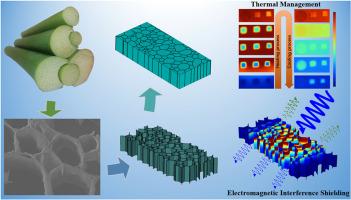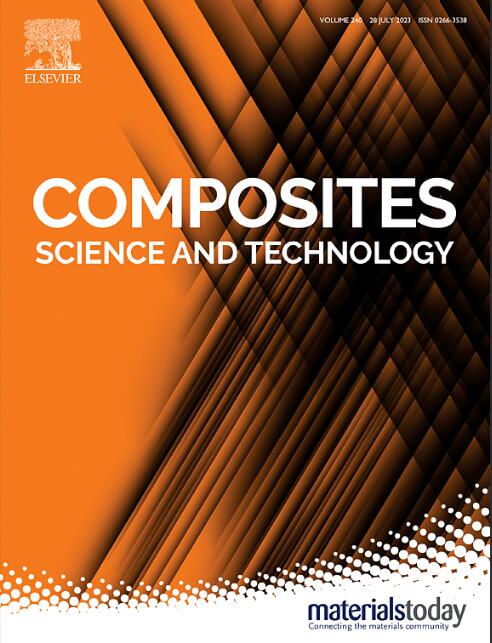用于微波能量衰减和热能储存的碳化芋头茎轻质复合材料
IF 8.3
1区 材料科学
Q1 MATERIALS SCIENCE, COMPOSITES
引用次数: 0
摘要
研究人员开发了一种新型战略,用于制备从芋头茎中提取的多孔碳材料,旨在增强电磁波(EMW)衰减和热能存储。这种材料是通过碳化芋头茎形成多孔碳结构,然后用含有碳纳米管(CNTs)和镍(Ni)纳米颗粒的聚乙二醇(PEG)进行增强而合成的。通过调整碳化温度以及碳纳米管和镍的负载量,所得到的碳材料表现出卓越的电磁波衰减性能。具体来说,PC-800 样品在 8.2-11 GHz 频率范围内的最小反射损耗为 -61.4 dB,密度低至 0.054 g/cm³。PC-1200 样品在 X 波段的轴向 EMI SE 值为 23.6 dB,径向 EMI SE 值为 21.5 dB,密度超低,仅为 0.033 g/cm³。PC/CNT2 和 PC/CNT2-Ni15 复合材料的 EMI SE 值进一步提高,分别达到 26.3 dB 和 26.8 dB。此外,这些复合材料还表现出有效的热能存储和释放,这一点已通过加热实验得到证实。这项研究不仅介绍了一种制造以吸收为主的生物质电磁屏蔽材料的方法,还为提高电子设备的性能提供了一种双功能解决方案。本文章由计算机程序翻译,如有差异,请以英文原文为准。

Lightweight composites derived from carbonized taro stems for microwave energy attenuation and thermal energy storage
A novel strategy has been developed for preparing porous carbon materials derived from taro stems, aimed at enhancing electromagnetic wave (EMW) attenuation and thermal energy storage. The materials were synthesized through the carbonization of taro stems to form a porous carbon structure, subsequently enhanced with polyethylene glycol (PEG) containing carbon nanotubes (CNTs) and nickel (Ni) nanoparticles. By adjusting the carbonization temperature and the loading of CNTs and Ni, the resulting carbon materials exhibited exceptional EMW attenuation performance. Specifically, the PC-800 sample demonstrated a remarkable minimum reflection loss of −61.4 dB across the frequency range of 8.2–11 GHz, with a low density of 0.054 g/cm³. The PC-1200 sample exhibited EMI SE values of 23.6 dB axially and 21.5 dB radially in the X-band, with an ultra-low density of 0.033 g/cm³. Further enhancements were observed in the PC/CNT2 and PC/CNT2-Ni15 composites, achieving EMI SE values of 26.3 dB and 26.8 dB, respectively. Additionally, these composites exhibited effective thermal energy storage and release, as confirmed by heating experiments. This study not only introduces a method for creating absorption-dominated biomass electromagnetic shielding materials but also provides a dual-functional solution for enhancing the performance of electronic devices.
求助全文
通过发布文献求助,成功后即可免费获取论文全文。
去求助
来源期刊

Composites Science and Technology
工程技术-材料科学:复合
CiteScore
16.20
自引率
9.90%
发文量
611
审稿时长
33 days
期刊介绍:
Composites Science and Technology publishes refereed original articles on the fundamental and applied science of engineering composites. The focus of this journal is on polymeric matrix composites with reinforcements/fillers ranging from nano- to macro-scale. CSTE encourages manuscripts reporting unique, innovative contributions to the physics, chemistry, materials science and applied mechanics aspects of advanced composites.
Besides traditional fiber reinforced composites, novel composites with significant potential for engineering applications are encouraged.
 求助内容:
求助内容: 应助结果提醒方式:
应助结果提醒方式:


